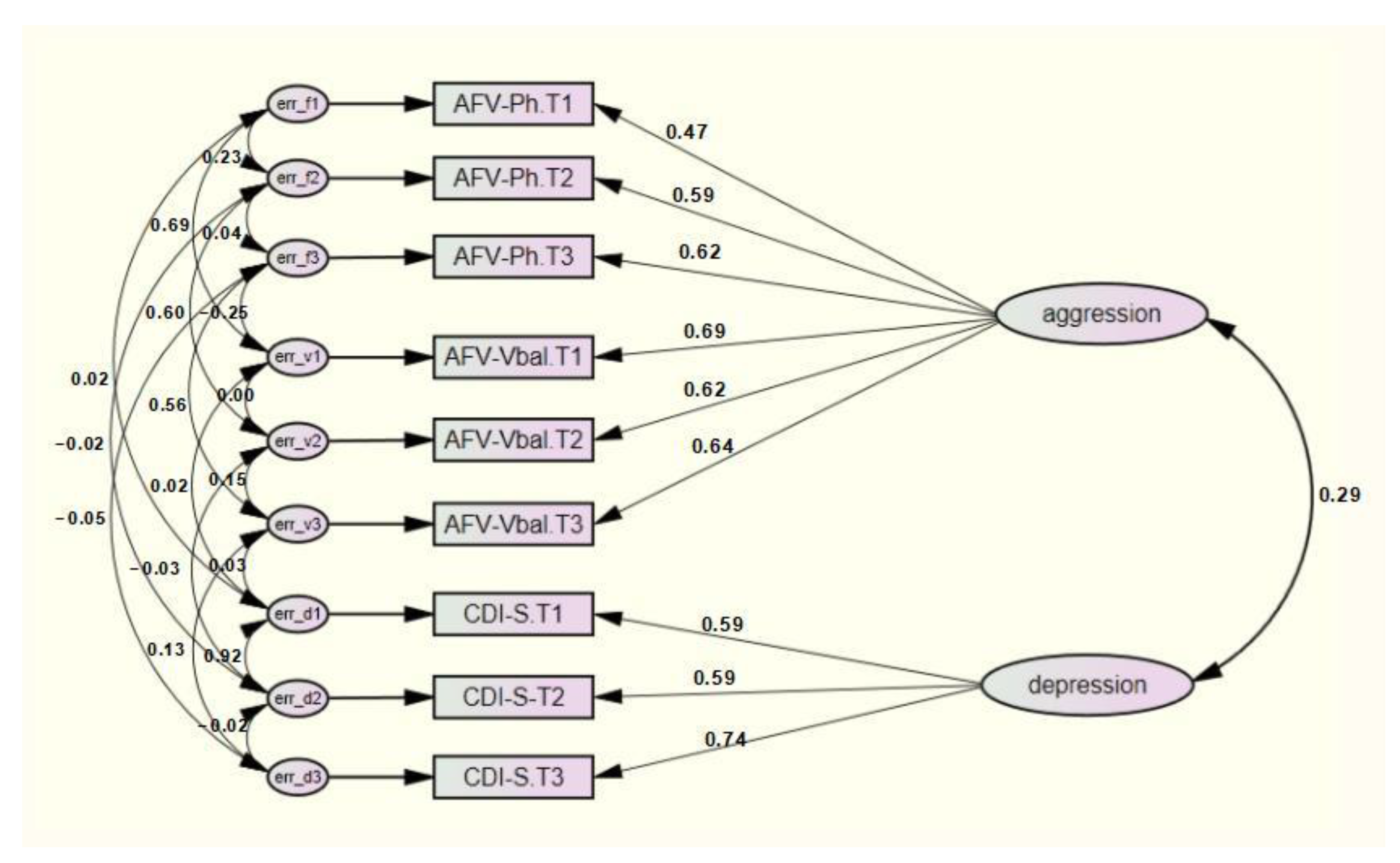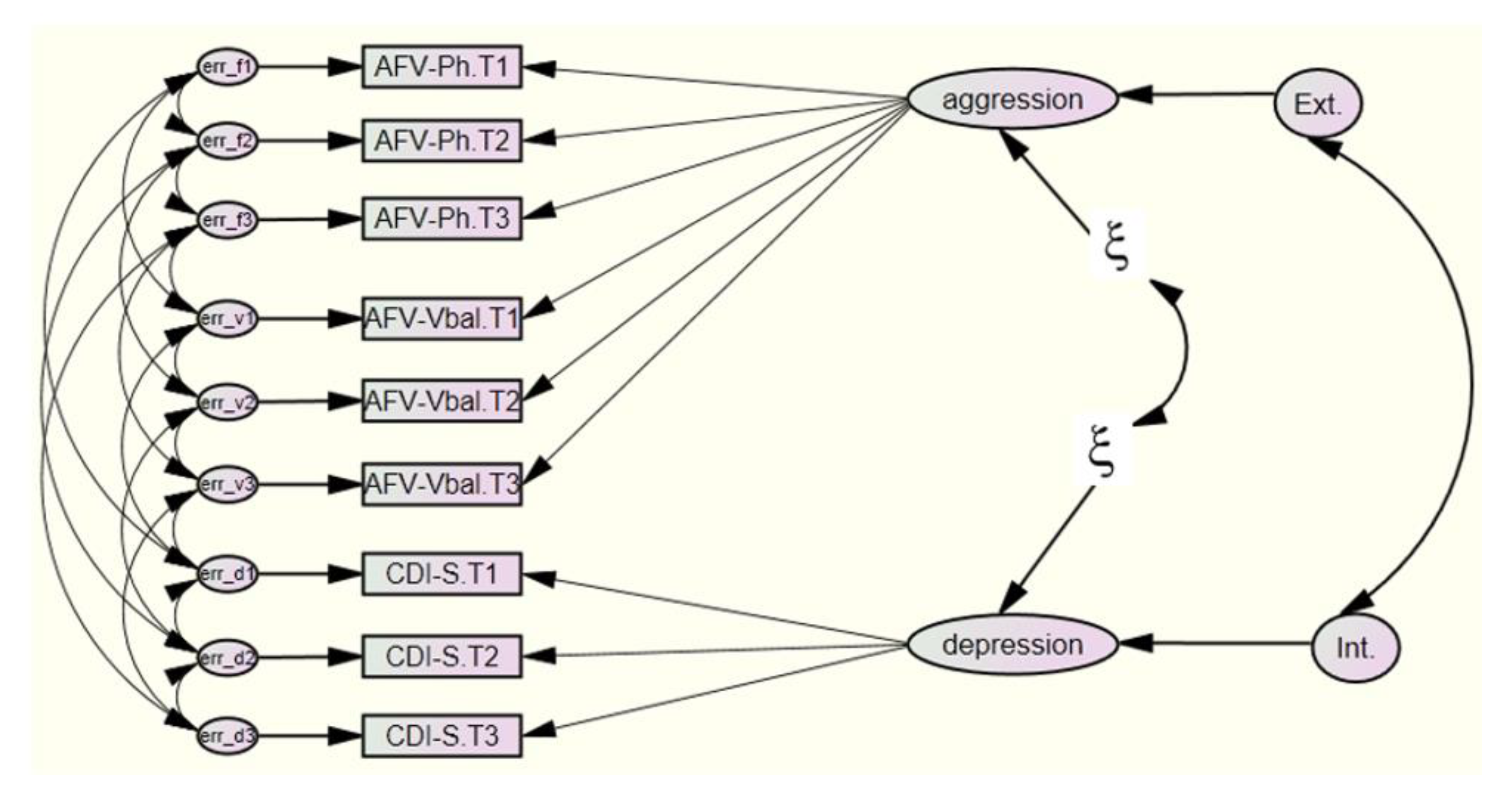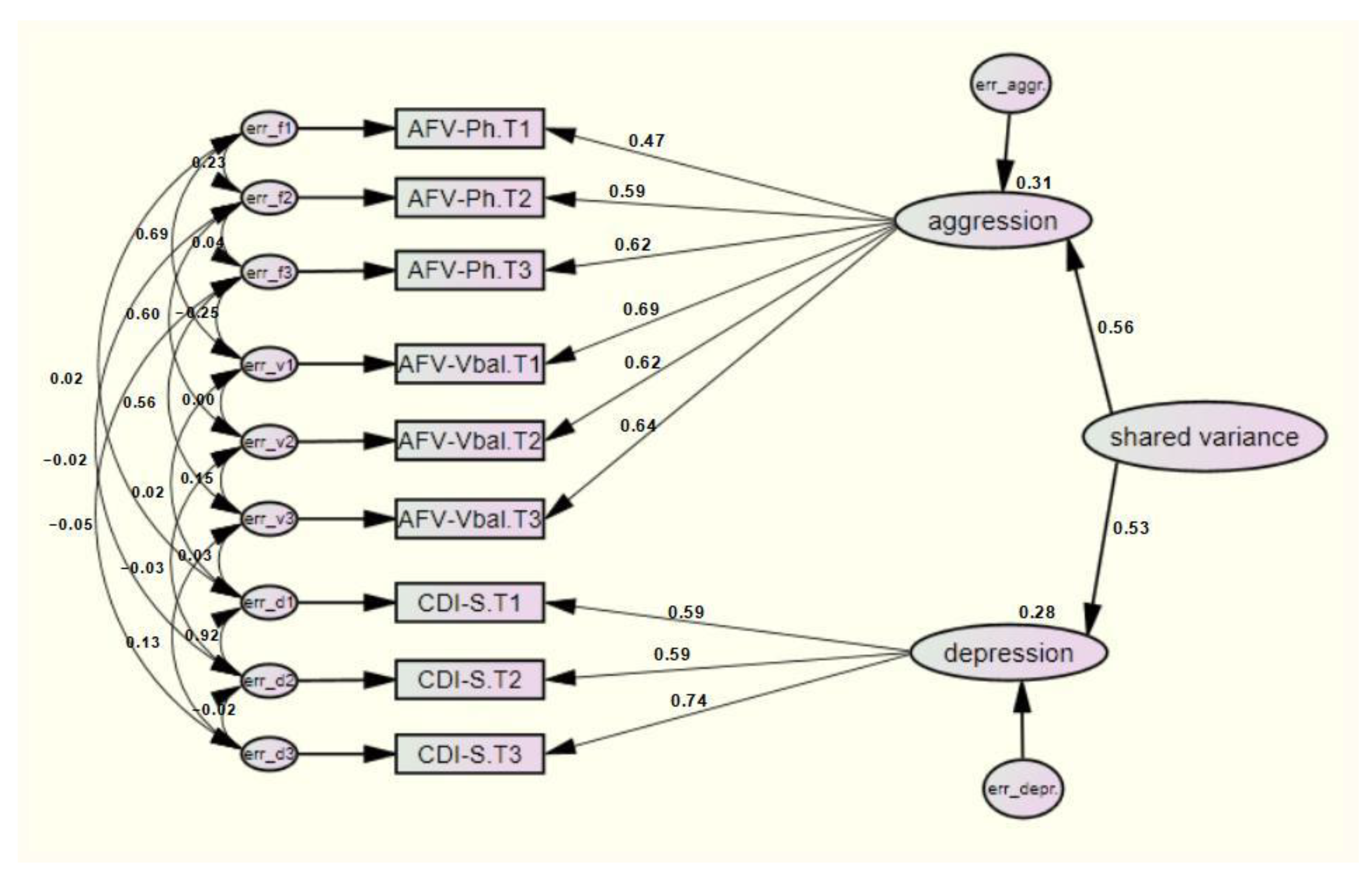Confirmatory Factor Analysis of Comorbidity between Depression and Aggression in a Child-Adolescent Community Sample: Nosological, Prognosis and Etiological Implications
Abstract
1. Introduction
2. Materials and Methods
2.1. Participants
2.2. Procedure
2.3. Instruments
2.4. Statistical Analysis
3. Results
4. Discussion
5. Conclusions
Author Contributions
Funding
Institutional Review Board Statement
Informed Consent Statement
Data Availability Statement
Conflicts of Interest
References
- Ollendick, T.H.; King, N.J.; Muris, P. Fears and phobias in children: Phenomenology, epidemiology, and aetiology. Child Adolesc. Ment. Health 2002, 7, 98–106. [Google Scholar] [CrossRef]
- Clark, L.A.; Watson, D. Tripartite model of anxiety and depression: Psychometric evidence and taxonomic implications. J. Abnorm. Psychol. 1991, 100, 316–336. [Google Scholar] [CrossRef] [PubMed]
- Gordillo, R.; del Barrio, V.; Carrasco, M.A. Análisis longitudinal de la comorbilidad entre depresión y agresión: Cronicidad y severidad en sujetos de 11 a 13 años Longitudinal analysis of comorbidity between depression and aggression chronicity and severity in individuals 11 to 13 years. Interdiscip. Rev. De Psicol. Y Cienc. Afines 2012, 29, 165–185. [Google Scholar]
- Angold, A.; Costello, E.J.; Erkanli, A. Comorbidity. J. Child Psychol. Psychiatry 1999, 40, 57–87. [Google Scholar] [CrossRef] [PubMed]
- McDonough-Caplan, H.; Klein, D.N.; Beauchaine, T.P. Comorbidity and continuity of depression and conduct problems from elementary school to adolescence. J. Abnorm. Psychol. 2018, 127, 326–337. [Google Scholar] [CrossRef]
- Lilienfeld, S.O. Comorbidity between and within childhood externalizing and internalizing disorders: Reflections and directions. J. Abnorm. Child Psychol. 2003, 31, 285–291. [Google Scholar] [CrossRef]
- Dutton, D.G.; Karakanta, C. Depression as a risk marker for aggression: A critical review. Aggress. Violent Behav. 2013, 18, 310–319. [Google Scholar] [CrossRef]
- Beauchaine, T.P.; Webster-Stratton, C.; Reid, M.J. Mediators, Moderators, and Predictors of 1-Year Outcomes Among Children Treated for Early-Onset Conduct Problems: A Latent Growth Curve Analysis. J. Consult. Clin. Psychol. 2005, 73, 371–388. [Google Scholar] [CrossRef]
- Essau, C.; de la Torre-Luque, A. Comorbidity profile of mental disorders among adolescents: A latent class analysis. Psychiatry Res. 2019, 278, 228–234. [Google Scholar] [CrossRef]
- Achenbach, T.M. ‘Comorbidity’ in child and adolescent psychiatry: Categorical and quantitative perspectives. J. Child. Adolesc. Psychopharmacol. 1990, 1, 271–278. [Google Scholar] [CrossRef]
- Garber, J.; Quiggle, N.L.; Panak, W.; Dodge, K.A. Aggression and depression in children: Comorbidity, specificity, and social cognitive processing. In Internalizing and Externalizing Expressions of Dysfunction; Chicchetti, D., Sheree, L., Eds.; Lawrence Erlbaum Associates: Hillsdale, MI, USA, 1991; pp. 225–264. [Google Scholar]
- Wichstrøm, L.; Berg-Nielsen, T.S.; Angold, A.; Egger, H.L.; Solheim, E.; Sveen, T.H. Prevalence of psychiatric disorders in preschoolers. J. Child. Psychol. Psychiatry 2012, 53, 695–705. [Google Scholar] [CrossRef] [PubMed]
- Rhee, S.H.; Lahey, B.B.; Waldman, I.D. Comorbidity among dimensions of childhood psychopathology: Converging evidence from behavior genetics. Child. Dev. Perspect. 2015, 9, 26–31. [Google Scholar] [CrossRef] [PubMed]
- Tremblay, R.E.; Nagin, D.S.; Seguin, J.R.; Zoccolillo, M.; Zelazo, P.D.; Boivin, M.; Japel, C. Physical aggression during early childhood: Trajectories and predictors. Can Child. Adolesc Psychiatry Rev. 2005, 14, 3–9. [Google Scholar] [CrossRef] [PubMed]
- Vasileva, M.; Graf, R.K.; Reinelt, T.; Petermann, U.; Petermann, F. Research review: A meta-analysis of the international prevalence and comorbidity of mental disorders in children between 1 and 7 years. J. Child. Psychol. Psychiatry 2021, 62, 372–381. [Google Scholar] [CrossRef] [PubMed]
- Quiggle, N.L.; Garber, J.; Panak, W.F.; Dodge, K.A. Social information processing in aggressive and depressed children. Child. Dev. 1992, 63, 1305–1320. [Google Scholar] [CrossRef]
- Rudolph, K.D.; Clark, A.G. Conceptions of relationships in children with depressive and aggressive symptoms: Social-cognitive distortion or reality? J. Abnorm. Child. Psychol. 2001, 29, 41–56. [Google Scholar] [CrossRef]
- Knox, M.; King, C.; Hanna, G.L.; Logan, D.; Ghaziuddin, N. Aggressive behavior in clinically depressed adolescents. J. Am. Acad. Child. Adolesc. Psychiatry 2000, 39, 611–618. [Google Scholar] [CrossRef]
- Eaton, N.R. Latent variable and network models of comorbidity: Toward an empirically derived nosology. Soc. Psychiatry Psychiatr. Epidemiol. Int. J. Res. Soc. Genet. Epidemiol. Ment. Health Serv. 2015, 50, 845–849. [Google Scholar] [CrossRef]
- Valderas, J.M.; Starfield, B.; Sibbald, B.; Salisbury, C.; Roland, M. Defining comorbidity: Implications for understanding health and health services. Ann. Fam. Med. 2009, 7, 357–363. [Google Scholar] [CrossRef]
- Clark, L.A.; Watson, D.; Reynolds, S. Diagnosis and classification of psychopathology: Challenges to the current system and future directions. Annu. Rev. Psychol. 1995, 46, 121–153. [Google Scholar] [CrossRef]
- Youngstrom, E.A.; Findling, R.L.; Calabrese, J.R. Who are the comorbid adolescents? Agreement between psychiatric diagnosis, youth, parent, and teacher report. J. Abnorm. Child. Psychol. 2003, 31, 231–245. [Google Scholar] [PubMed]
- Teesson, M.; Degenhardt, L.; Proudfoot, H.; Hall, W.; Lynskey, M. How common is comorbidity and why does it occur? Aust. Psychol. 2005, 40, 81–87. [Google Scholar] [CrossRef]
- Achenbach, T.M. Diagnosis, assessment, and comorbidity in psychosocial treatment research. J. Abnorm. Child. Psychol. Off. Publ. Int. Soc. Res. Child. Adolesc. Psychopathol. 1995, 23, 45–65. [Google Scholar] [CrossRef] [PubMed]
- Islam, M.M.; Valderas, J.M.; Yen, L.; Dawda, P.; Jowsey, T.; McRae, I.S. Multimorbidity and Comorbidity of Chronic Diseases among the Senior Australians: Prevalence and Patterns. PLoS ONE 2014, 9, e83783. [Google Scholar] [CrossRef] [PubMed]
- Achenbach, T.M.; Edelbrock, C.S. The classification of child psychopathology: A review and analysis of empirical efforts. Psychol. Bull. 1978, 85, 1275–1301. [Google Scholar] [CrossRef]
- Angold, A.; Costello, E.J. Comorbidity in children and adolescents with depression. Child. Adolesc. Psychiatry Clin. N. Am. 1992, 1, 31–51. [Google Scholar] [CrossRef]
- Cicchetti, D.; Toth, S.L. A developmental perspective on internalizing and externalizing disorders. In Internalizing and Externalizing Expressions of Dysfunction; Chicchetti, D., Toth, S.L., Eds.; Lawrence Erlbaum Associates: Hillsdale, MI, USA, 1991; pp. 1–19. [Google Scholar]
- Hogansen, J.M. Trajectories of co-occurring aggressive and depressive symptoms in children: Prediction from child and family characteristics. In Dissertation Abstracts International: Section B: The Sciences and Engineering; ProQuest Information & Learning: Ann Arbor, MI, USA, 2004; p. 3163. [Google Scholar]
- Lee, J.; Choi, K.S. Longitudinal Structural Equation Modeling of Internet Game and Aggression in Children. Open J. Nurs. 2015, 5, 11. [Google Scholar] [CrossRef][Green Version]
- Weiss, B.; Catron, T. Specificity of the comorbidity of aggression and depression in children. J. Abnorm. Child. Psychol. 1994, 22, 389–401. [Google Scholar] [CrossRef]
- Achenbach, T.M.; Ivanova, M.Y.; Rescorla, L.A.; Turner, L.V.; Althoff, R.R. Internalizing/Externalizing Problems: Review and Recommendations for Clinical and Research Applications. J. Am. Acad. Child. Adolesc. Psychiatry 2016, 55, 647–656. [Google Scholar] [CrossRef]
- Wolff, J.C.; Ollendick, T.H. The comorbidity of conduct problems and depression in childhood and adolescence. Clin. Child. Fam. Psychol. Rev. 2006, 9, 201–220. [Google Scholar] [CrossRef]
- Capaldi, D.M. Co-occurrence of conduct problems and depressive symptoms in early adolescent boys: II. A 2-year follow-up at Grade 8. Dev. Psychopathol. 1992, 4, 125–144. [Google Scholar] [CrossRef]
- Egger, H.L.; Angold, A. Common emotional and behavioral disorders in preschool children: Presentation, nosology, and epidemiology. J. Child. Psychol. Psychiatry 2006, 47, 313–337. [Google Scholar] [CrossRef] [PubMed]
- Cochran, W.G. Sampling Techniques, 2nd ed.; John Wiley and Sons: Hoboken, NJ, USA, 1963. [Google Scholar]
- Kovacs, M. Children’s Depression Inventory, CDI; Multi-Heath Systems: Toronto, ON, Canada, 1992. [Google Scholar]
- Colodrón Gómez, M.F.; Olmedo Montes, M.; Barrio, M.V.D.; Roa Capilla, M.L. Primera adaptación del CDI-S a población española First adaptation of the CDI-S to the Spanish population. Acción Psicológica 2002, 1, 263–272. [Google Scholar]
- Caprara, G.V.; Pastorelli, C. Early emotional instability, prosocial behaviour, and aggression: Some methodological aspects. Eur. J. Personal. 1993, 7, 19–36. [Google Scholar] [CrossRef]
- Del Barrio, V.; Moreno, C.; López, R. Evaluación de la agresión y la inestabilidad emocional en niños españoles: Su relación con la depresión. Clínica Y Salud 2001, 12, 33–50. [Google Scholar]
- Hox, J.J.; Bechger, T.M. An introduction to structural equation modeling. Fam. Sci. Rev. 1988, 11, 354–373. [Google Scholar]
- Byrne, B.M. Structural Equation Modeling with AMOS Basic Concepts, Applications, and Programming; Multivariate Applications Book Series; Lawrence Erlbaum: Mahwah, NJ, USA, 2001; p. 338. [Google Scholar]
- Catena, A.; Ramos, M.M.; Trujillo, H.M. Análisis Multivariado: Un Manual Para Investigadores; Manuales y obras de referencia. Serie Psicología; Biblioteca Nueva: Madrid, Spain, 2003; p. 413. [Google Scholar]
- Steiger, J.H. Structural model evaluation and modification: An interval estimation approach. Multivar. Behav. Res. 1990, 25, 173–180. [Google Scholar] [CrossRef]
- Hu, L.T.; Bentler, P.M. Cutoff criteria for fit indexes in covariance structure analysis: Conventional criteria versus new alternatives. Struct. Equ. Modeling Multidiscip. J. 1999, 6, 1–55. [Google Scholar] [CrossRef]
- Bentler, P.M.; Bonett, D.G. Significance tests and goodness of fit in the analysis of covariance structures. Psychol. Bull. 1980, 88, 588–606. [Google Scholar] [CrossRef]
- Hoelter, J.W. The Analysis of Covariance Structures: Goodness-of-Fit Indices. Sociol. Methods Res. 1983, 11, 325–344. [Google Scholar] [CrossRef]
- Mai, R.; Niemand, T.; Craus, S. A tailored-fit model evaluation strategy for better decisions about structural equation models. Technol. Forecast. Soc. Chang. 2021, 173, 121142. [Google Scholar] [CrossRef]
- Beauchaine, T.P.; Constantino, J.N. Redefining the endophenotype concept to accommodate transdiagnostic vulnerabilities and etiological complexity. Biomark. Med. 2017, 11, 769–780. [Google Scholar] [CrossRef] [PubMed]
- Zisner, A.; Beauchaine, T.P. Neural substrates of trait impulsivity, anhedonia, and irritability: Mechanisms of heterotypic comorbidity between externalizing disorders and unipolar depression. Dev. Psychopathol. 2016, 28, 1177–1208. [Google Scholar] [CrossRef] [PubMed]
- Gootzeit, J.; Markon, K. Factors of PTSD: Differential specificity and external correlates. Clin. Psychol. Rev. 2011, 31, 993–1003. [Google Scholar] [CrossRef] [PubMed]



Publisher’s Note: MDPI stays neutral with regard to jurisdictional claims in published maps and institutional affiliations. |
© 2022 by the authors. Licensee MDPI, Basel, Switzerland. This article is an open access article distributed under the terms and conditions of the Creative Commons Attribution (CC BY) license (https://creativecommons.org/licenses/by/4.0/).
Share and Cite
Gordillo, R.; Del Barrio Gándara, M.V.; Carrasco, M.A. Confirmatory Factor Analysis of Comorbidity between Depression and Aggression in a Child-Adolescent Community Sample: Nosological, Prognosis and Etiological Implications. Int. J. Environ. Res. Public Health 2022, 19, 4424. https://doi.org/10.3390/ijerph19084424
Gordillo R, Del Barrio Gándara MV, Carrasco MA. Confirmatory Factor Analysis of Comorbidity between Depression and Aggression in a Child-Adolescent Community Sample: Nosological, Prognosis and Etiological Implications. International Journal of Environmental Research and Public Health. 2022; 19(8):4424. https://doi.org/10.3390/ijerph19084424
Chicago/Turabian StyleGordillo, Rodolfo, María Victoria Del Barrio Gándara, and Miguel A. Carrasco. 2022. "Confirmatory Factor Analysis of Comorbidity between Depression and Aggression in a Child-Adolescent Community Sample: Nosological, Prognosis and Etiological Implications" International Journal of Environmental Research and Public Health 19, no. 8: 4424. https://doi.org/10.3390/ijerph19084424
APA StyleGordillo, R., Del Barrio Gándara, M. V., & Carrasco, M. A. (2022). Confirmatory Factor Analysis of Comorbidity between Depression and Aggression in a Child-Adolescent Community Sample: Nosological, Prognosis and Etiological Implications. International Journal of Environmental Research and Public Health, 19(8), 4424. https://doi.org/10.3390/ijerph19084424





